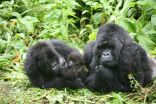Experimental Ebola treatment boosts survival in mice
2015-05-20
(Press-News.org) The number of new Ebola cases is tapering off, but the search for new treatments continues. Now, one research team has found potential drug candidates that successfully treated up to 90 percent of mice exposed to the Ebola virus. They report their findings in the journal ACS Infectious Diseases.
Bogdan A. Solaja, Rekha G. Panchal and colleagues note that the U.S. Food and Drug Administration has yet to approve any therapeutic drugs or vaccines against the Ebola virus that, since December 2013, has infected more than 25,000 people and taken the lives of more than 10,000. While some researchers are developing vaccines to prevent Ebola infections, others are focusing on treatments for the disease. They are investigating a number of compounds, including existing malaria and flu drugs. Solaja's team has been looking into possible treatments by studying a class of small molecules called diazachrysenes, which they've found in lab tests to be non-toxic and effective against the most potent bacterial toxin, botulinum neurotoxin. They wanted to screen this family of compounds for possible anti-Ebola drug candidates.
The researchers narrowed down their search to a handful of diazachrysenes. In their study, 70 to 90 percent of the mice that received one of three of the experimental compounds survived infection and didn't show any obvious side effects.
INFORMATION:
The authors acknowledge funding from the Ministry of Science and Technological Development of Serbia and the Defense Threat Reduction Agency.
The American Chemical Society is a nonprofit organization chartered by the U.S. Congress. With more than 158,000 members, ACS is the world's largest scientific society and a global leader in providing access to chemistry-related research through its multiple databases, peer-reviewed journals and scientific conferences. Its main offices are in Washington, D.C., and Columbus, Ohio.
To automatically receive news releases from the American Chemical Society, contact newsroom@acs.org.
Follow us: Twitter Facebook
ELSE PRESS RELEASES FROM THIS DATE:
2015-05-20
Despite efforts over decades to diversify the ranks of university faculty, only 4 percent of chemistry professorships at 50 leading U.S. colleges and universities are held by underrepresented minorities. That key finding and others related to diversity in academia came from a new survey conducted by a program called Open Chemistry Collaborative in Diversity Equity (OXIDE) in partnership with Chemical & Engineering News (C&EN), the weekly newsmagazine of the American Chemical Society.
Senior Editor Linda Wang and Assistant Managing Editor Sophie Rovner at C&EN report that ...
2015-05-20
HOUSTON - (May 20, 2015) - Whether people locate their sense of self in the brain or the heart can have a major influence on people's decision-making, according to a new study by management and business experts at Rice University and Columbia University.
Overall, the study found people tend to locate the self in the brain.
The paper, "Who You Are Is Where You Are: Antecedents and Consequences of Locating the Self in the Brain or the Heart," will be published in the journal Organizational Behavior and Human Decision Processes.
"We view our research as a first step ...
2015-05-20
Twitter 'big data' could provide valuable details about transgender individuals' health and social needs
Transgender and gender nonconforming people are at high risk for diseases such as AIDS and are vulnerable to depression and other mental health issues, but may be reluctant to disclose their identities to researchers due to stigma. As a result, very little is known about their health and social needs.
New research from the UC Institute for Prediction Technology in the UCLA Department of Family Medicine suggests that social media could help fill that knowledge gap. ...
2015-05-20
A multidisciplinary team led by Johns Hopkins researcher Venu Raman, Ph.D., with notable contributions from Guus Bol, Farhad Vesuna and Phuoc Tran of Johns Hopkins, has identified a new therapy for lung cancer, the most common cancer worldwide. The therapy has been in development for six years and involves a first-in-class molecule designed by the team. The molecule, RK-33, interrupts the cell cycle of lung cancer cells without harming normal cells, and it is effective both on its own and in combination with radiation therapy.
The team designed the molecule to bind to ...
2015-05-20
LAWRENCE -- Whole Foods Market encourages its employees to connect with the supermarket's "core values" on a personal level and make them "come to life" every day in their work.
Whether it's at the organic foods supermarket or firms such as Google or Apple or even Southwest Airlines, cohesive corporate culture is a strong buzzword among some of the world's most successful companies.
However, a University of Kansas researcher who studies the intersection of economics, evolutionary theory and philosophy has found that strong culture among a business' employees is only ...
2015-05-20
The drug dasabuvir (trade name Exviera) has been available since January 2015 for the treatment of adults with chronic hepatitis C infection. The German Institute for Quality and Efficiency in Health Care (IQWiG) examined in a dossier assessment whether this drug offers an added benefit over the appropriate comparator therapy.
According to the findings, there are indications of an added benefit in patients who have not yet developed cirrhosis of the liver and who are infected with the hepatitis C virus (HCV) genotype 1a. In case of genotype 1b, this only applies to treatment-naive, ...
2015-05-20
Radio systems, such as mobile phones and wireless internet connections, have become an integral part of modern life. However, today's devices use twice as much of the radio spectrum as is necessary. New technology is being developed that could fundamentally change radio design and could increase data rates and network capacity, reduce power consumption, create cheaper devices and enable global roaming.
A pioneering team of researchers from the University of Bristol's Communication Systems and Networks research group, have developed a new technique that can estimate ...
2015-05-20
Oral care products containing a natural chemical that stops bacteria harming teeth could help prevent decay, a study suggests.
The plant natural product acts against harmful mouth bacteria and could improve oral health by helping to prevent the build-up of plaque, researchers say.
The compound - known as trans-chalcone - is related to chemicals found in liquorice root. The study shows that it blocks the action of a key enzyme that allows the bacteria to thrive in oral cavities.
The bacteria - Streptococcus mutans - metabolise sugars from food and drink, which produces ...
2015-05-20
Some mountain gorilla females linger into adulthood in the group into which they were born. In the process, they also remain in the company of their father, who is often their group's dominant male. To curb inbreeding, though, they appear to tactically avoid mating with their fathers. This strategy works so well that the chances of alpha gorilla males siring the offspring of their own daughters are effectively zero, according to Linda Vigilant of the Max Planck Institute for Anthropology in Germany. The findings are published in Springer's journal Behavioral Ecology and ...
2015-05-20
CAMBRIDGE, Mass--Researchers have found a way to couple the properties of different two-dimensional materials to provide an exceptional degree of control over light waves. They say this has the potential to lead to new kinds of light detection, thermal-management systems, and high-resolution imaging devices.
The new findings -- using a layer of one-atom-thick graphene deposited on top of a similar 2-D layer of a material called hexagonal boron nitride (hBN) -- are published in the journal Nano Letters. The work is co-authored by MIT associate professor of mechanical engineering ...
LAST 30 PRESS RELEASES:
[Press-News.org] Experimental Ebola treatment boosts survival in mice


